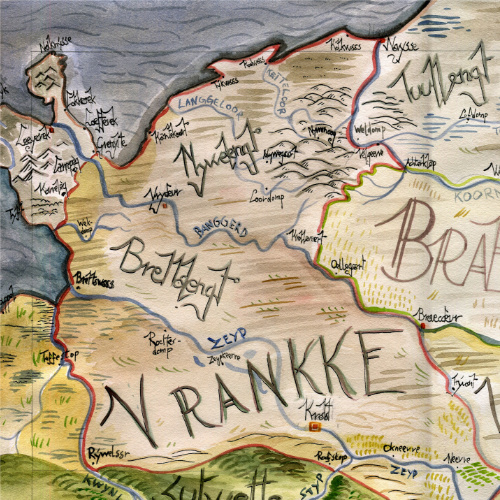
“Deyne Kratat, Sgoone Renegaate”
“Witseege Kratat,
Sgoone Renegaate
–
ik ken uu Hart.
Duusthooge Stad
–
kent gy het myne?”*
THE GREAT CITY OF KRATAT has older, richer and more populous neighbors in the lands of Bos, but none can rival its diverse, riveting history. Nestled on a sizeable island in the river Zeyp*, it lies a good ways south of most other urban centers, relatively sheltered from external assault or occupation.
THE FIRST MENTION of Kratat takes us back to a time where societies were tribal, and divided by breed. Nowadays their authentic names elude us, but three such tribes built their Weerhuys† on the island. One on each opposing end, and the third lay in their middle. Primeval Kratat was located on the upstream shore, by the East side. Here lived the tribal community that eventually seized the whole island by force:
“The rays of the sun shone bright, pierced
And blinded
The eyes of the Yellow warriors
Kratat took their hands so fight they could not”
“Numerous were the Blue
But warriors they were not
Driven to the water, by blow and by hack
Kratat took their feet so swim they could not.”
“Sun and Stream
May burn the Yellow
May drown the Blue
But never the strongest
Never Kratat”
TIME TRICKLED as Time does, and after centuries, a sprawling cosmopolis has covered every inch of the island.
The fierce city has known many intermittent periods of growth and splendor, separated by sequences of harsh internal strife. Most famous and merciless is the period dubbed the Valsse Kratat‡, when the friction of socio-political tension sparked the flame of revolution and erupted in spectacular fashion. Over the course of a decade a dozen rulers were abdicated, reinstated and garotted. Hundreds of revolutionaries were exiled, imprisoned or strung up. Thousands of citizens suffered throughout and many would have accepted execution over starvation or mistreatment, such as they had to endure.
The troops of Marktelaer assaulting the gates!
–detail from the ‘Valsse Kratat’
DESPITE ALL THIS, the city has always been and remains a leading example in design, literature and the fine arts of w(h)ining and dining.
Notes
*The closing line of the poem “Valsse”, by Rikkard Hoogevlugt, the translation reads:
“White blessed Kratat, beautiful renegade – I know your heart. City of a thousand heights – do you know mine?“
Zeyp — The course of this river, and the general surroundings of Kratat are depicted of this map of southern Bos.
Weerhuys — outdated fort design, a stone roundhouse with palisades.
Valsse Kratat — The Kratat Waltz, a period in recent Kratat history of coups, rebellions and revolutions.
Deyne Kratat — Weltering Kratat, a common nickname when referring to Kratat.
Witseege Kratat — White Blessed Kratat, a name that echoes a time where princes of Kratat would cover the entire city and its walls with chalk.
Chalk played an important role in the superstitions of olden days.
Duusthooge Stad — City of a Thousand Heights, in reference to Kratats city walls and towers, which have steadily increased in both number and size over the past centuries.
Sgoone Renegaate — Beautiful Renegade, this name was popularized during the Valsse Kratat, specifically those episodes where nobility and gentry were ousted from the city.







